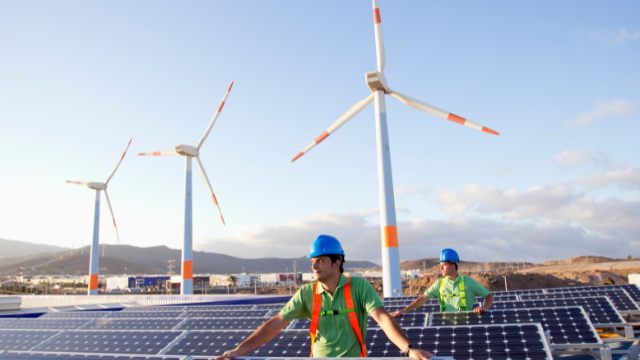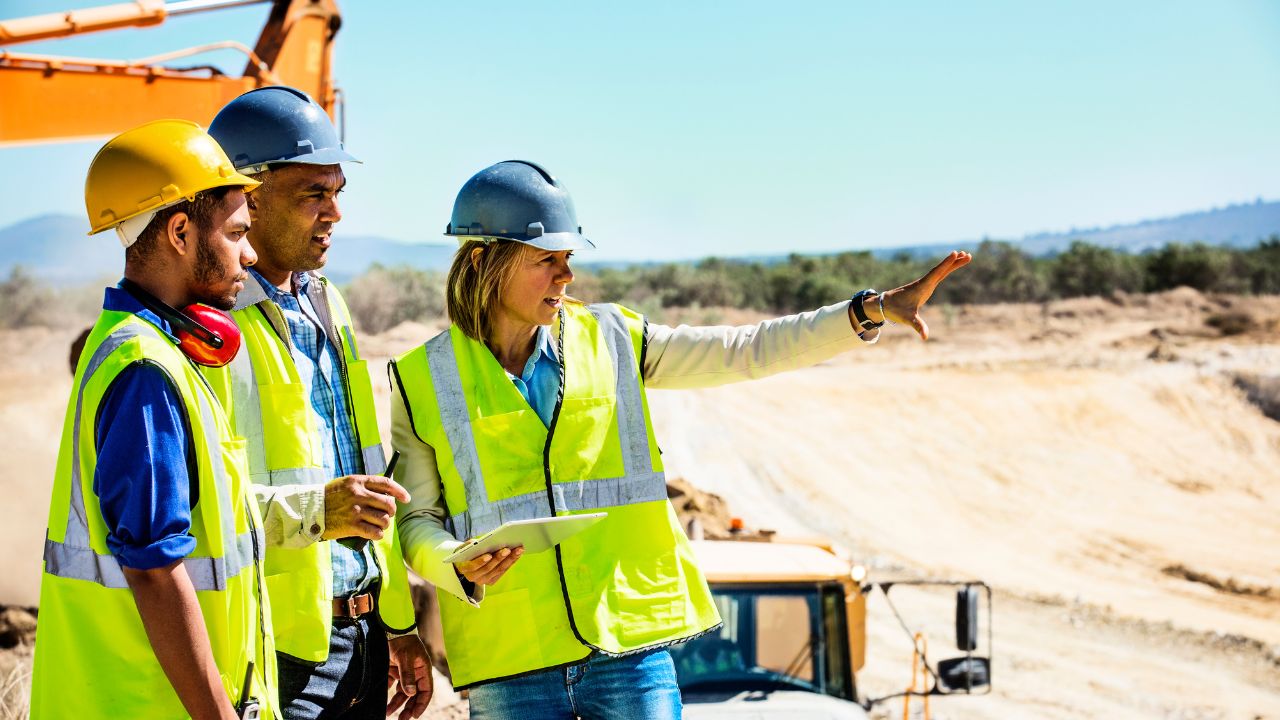Managing Renewable Energy Recruitment for Remote Job Sites
05 Feb, 202414 minsWhether location-specific projects focus on maintaining a wind turbine in the Fujian Provinc...

Whether location-specific projects focus on maintaining a wind turbine in the Fujian Province of China or installing a solar farm in the Thar Desert of Rajasthan, India, sourcing and placing talent in renewable energy jobs based in remote sites is commonplace in the industry. Despite the importance of remote work sites within the renewables space, not all employers fully understand how to effectively manage their approach to remote renewable energy recruitment.
In this blog, we're focusing on the steps you can apply to your renewable energy recruitment strategy to help you manage the talent acquisition of professionals working on your remote projects. From prioritising communication and building a culture of trust to leveraging existing and emerging technologies, honing in on remote onboarding, and understanding global regulations, this guide details how to establish a successful remote hiring strategy for your business.
This blog explores the following ways you can effectively manage your approach to remote renewable energy recruitment:
- Remote work sites require you to prioritise communication
- Build a culture of trust with remote renewable energy talent
- Utilise existing and emerging technologies
- Hone in on remote onboarding for renewable energy talent
- Understand the global regulations of remote hiring
Remote work sites require you to prioritise communication
Our first step in managing renewable energy recruitment for remote work sites is to ensure that communication remains a priority. Communication is crucial to any business and the success of its renewable projects - even more so when managing a remote workforce. Prioritising communication encourages collaboration, fosters cohesion and enhances knowledge even when employees are dispersed globally.
- Communicate Expectations with Your Remote Workforce
Regarding communication, it is imperative to define and set clear expectations for your hires in remote renewable energy jobs. These expectations include working hours, role responsibilities, and workflow schedules.
With this information, each employee will know when their teammates are working, what they're responsible for, and what they are working on day to day. This level of communication for remote renewable energy projects allows staff to respect their colleagues' time and communicate seamlessly and effectively regardless of the location of the remote job sites.
- Set up Virtual Meetings
Establishing frequent virtual meetings is one way to facilitate communication across each department and the wider business. These meetings could be daily, weekly, monthly, or whenever necessary. Here, your employees can set agendas to discuss the remote project goals, timelines for work schedules, and resource allocation.
If you have talent in remote renewable energy jobs working across the globe, the timing of these virtual meetings may vary. Some calls may be first thing in the day or last thing at night, depending on where the remote work sites are based.
- Consider Language Barriers
Employees will speak different languages depending on where they are in the world, their background and the remote job sites where they’re based. It's worth considering using simplified languages and phrases suitable for each region. Doing so can help align communication with the company's common goals. These phrases and cultural norms can be taught at the onboarding stage of your remote talent acquisition strategy - a step we'll discuss more of later in this guide.
When prioritising communication as part of your remote renewable energy recruitment needs, you must structure your business with clear and culturally sensitive best practices for communication. Doing so allows you to lay the foundation of a cohesive and high-performing team of workers capable of achieving your targets and completing your innovative remote projects anywhere in the world.
Build a culture of trust with remote renewable energy talent
Building a culture of trust is paramount for remote hiring, both for the success of your remote workforce and your business's overall function. Establishing an environment with transparency at the helm can support your remote talent acquisition and employee retention, as people feel valued and part of the broader organisational structure regardless of the region in which they’re based.
Here’s what you should consider when building a culture of trust as part of your remote hiring efforts and renewable energy recruitment strategy:
- Establish a local operation
Ensuring good communication channels with your main office or senior supervisors is essential for remote sites. One of the best ways to manage and support employees is to provide on-site, face-to-face interaction with supervisors and managers where possible.
Establish a local office where employees and contractors can meet with their teams and leaders regularly, ask questions and feedback, and raise any HR concerns. A supportive local presence will lessen the feeling of working alone, build bonds within the team, and ensure their concerns can be addressed promptly.
As mentioned before, it is also important that your remote workforce can communicate in their own language. Staffing the office with local or knowledgeable support is important for fostering positive connections across your remote renewable energy projects.
- Establish Open Communication Channels
A good step to building a culture of trust within your remote workforce is ensuring your chosen communication channels are accessible to everyone in the business. Here, senior leadership and management members should be on hand to support your colleagues with urgent queries around the clock.
These open communication channels ensure that even if team members are out of hours on the other side of the world, those working have people they can go to and trust - whether it’s work-related or personal queries and issues. It also reinforces trust and transparency between your remote staff and leadership talent.
- Group and One-to-One Check-ins
Another way to build a culture of trust with talent operating in remote renewable energy jobs is to utilise virtual chat channels for regular group and one-to-one check-ins. In addition to having regular meetings to discuss remote projects, as mentioned in our previous point, these additional sessions and communication can focus on how your employees feel personally and professionally.
It encourages open communication, allowing your people to share their challenges and achievements while building trust with other employees who have had relatable experiences working on remote job sites. Facilitating these accessible communication channels between your remote workforce can encourage mutual support. Doing so can strengthen relationships within your remote teams, creating a transparent atmosphere where obstacles are overcome collectively.
When allocating this time, finding a balance that allows your remote renewable energy talent to have trusted internal avenues where they feel heard and valued while ensuring they have time to complete their work on remote sites is essential.
- Allow Your Remote Hires Autonomy
Having made remote hiring a core part of your business model and renewable energy recruitment strategy means you’ve likely embraced at least some form of flexibility and trust with your employees. This trust should continue in the shape of autonomy to retain your existing workforce and bolster your remote talent acquisition goals.
Trust is a two-way street, so avoid micromanaging and instead trust in the ability of your remote workforce. Remember, these are high-level professionals you’ve hired to bring your remote renewable energy projects to life.
Therefore, have faith in their ability to work remotely to your predefined standards and meet your expectations. If you want to monitor how your remote hires are working, set performance reviews with clear metrics rather than micromanaging simply because they’re working from home.
Ultimately, if you show trust to your workers based on remote job sites, this trust will be reciprocated. The transparency that flows both ways will enable you to build a culture of trust with your remote renewable energy jobs that the market’s leading innovators will want to be a part of.
Utilise existing and emerging technologies
On the subject of managing talent acquisition for remote renewable energy projects, we’ve discussed the need to prioritise communication and build a culture of trust through the overarching means of open channels. These channels involve utilising existing and emerging technologies to address communication challenges, enhance operations, and make processes and workflows within your various remote projects seamless.
Regarding the utilisation of existing and emerging technologies, here’s what you should consider:
- Provide Necessary Equipment
If your budget allows, provide your remote workforce with the necessary equipment to complete their daily duties and communicate with the wider company. This equipment, from laptops and monitors to other work-related tools, should remain consistent with all employees across the business where possible to minimise the issues of device variations.
- Cloud-Based Software
Along with the physical hardware, such as laptops, you should consider utilising cloud-based solutions to support remote hires operating across your various renewable energy projects. Working on the cloud allows for seamless communication and collaboration, which is essential for managing successful remote workforces.
- Digital Communication Tools
Of course, you may have already implemented this during the pandemic. However, it’s worth investing in digital communication tools such as Zoom and Microsoft Teams to support your remote hiring strategies to support communication across your multinational teams and remote hires.
It’s also worth scoping the market for workflow, productivity and HR management tools to establish a well-rounded and efficient remote workforce. These tools should be supported by robust internet connection solutions, both for video communication and data transfer.
- Remote Interviews
These digital communication tools can also support your remote renewable energy recruitment strategy. You can use them to screen and interview your future hybrid workers. You may have experience interviewing candidates through virtual channels, which will be familiar.
However, if you’re new to this and want to focus your talent attraction through remote hiring, you’ll need to become accustomed to it. Thankfully, conducting interviews online through tools such as Zoom and Microsoft Teams is a seamless and effective alternative to traditional face-to-face interviews.
- Security Measures and Training
Cyber threats cost businesses an average of $4.45 million, resulting in severe reputational and financial damages. Therefore, it’s essential to implement security measures and training across the business to ensure your remote workers can operate your chosen existing and emerging tech securely and comply with specific regulations.
You should set standards and policies around passwords, encryption, and handling file sharing between your remote workers. Training to help your hybrid talent spot potential attacks from phishing and malware while implementing anti-malware software to safeguard sensitive data is a solid step to ensure your teams work safely online. You may also need to appoint an internal cyber security expert to support you with any tech-related issues or queries around the clock.
While security training is essential, you should also focus on training on the fundamentals of the tech and digital tools you use. Of course, most renewable energy talent will have experience with these digital tools and remote working. However, it’s still worth introducing them to ensure your new talent understands how your business operates and the approaches you take towards existing and emerging tech.
If you have the time and resources to complete this training internally, feel free to do so. However, outsourcing your cyber security to a third-party vendor may be worth considering, allowing you to focus primarily on your renewable projects. You could also do the same with your training, ensuring your remote talent knows how to use your digital tools and feel safe working online.
To summarise this section and to effectively manage remote hiring in renewables, utilise existing and emerging technologies to provide consistent equipment, leverage cloud-based solutions, and invest in digital communication tools. Conduct remote interviews using Zoom and Microsoft Teams and implement robust internal or external security measures and training to protect against cyber threats.
Hone in on remote onboarding for renewable energy talent
When it comes to remote renewable energy recruitment strategy, getting your onboarding right is paramount for ensuring your workforce kickstarts their time within your business with a positive and welcoming first impression. Getting your remote onboarding right is also essential to staff retention, ensuring your hires and contractors feel comfortable and confident that they’ve made the right decision to work on your remote projects.
As part of managing your remote hiring strategy, here are the steps to establishing a structured remote onboarding process:
- Provide a Comprehensive Overview
When onboarding remotely in renewable energy, it’s essential to provide your hires with a comprehensive overview of your company, their role, and what’s expected of them on your remote job sites. Whether through a senior professional or team leader, your remote workforce should be provided with detailed information on your business, from its mission, vision, values, and culture. You should also outline expectations, highlighted in our section on prioritising communication.
- Arrange Virtual Team Introductions
Introduce your remote workforce to their teammates using predefined digital communication tools. You could do this in one-to-one sessions or groups and involve team-building exercises or virtual social scenarios such as a coffee morning so your remote talent feels included and welcomed to the team.
Here, you could establish regular performance reviews and informal check-ins for the duration of a talent probation period. This part of your remote onboarding strategy sets the tone of open communication, trust, and transparency within your business, which are integral to managing remote hires. These sessions can provide feedback, highlight achievements, and address any challenges of your remote talent.
Consider introducing mentorship schemes whereby your remote hires are paired with an experienced team member to support them through the early stages of their career with you. This will establish a sense of guidance and accelerate learning and growth while ultimately promoting a supportive and inclusive work environment.
- Make Training Engaging
As part of your remote renewable energy recruitment onboarding process, your hires will be required to be trained and educated on various internal policies and projects. We mean anything from safety protocols, company standards and industry regulations to existing and upcoming remote renewable energy projects.
For your talent working solely from remote job sites, these training materials and knowledge must be engaging to maintain focus from your workforce. To increase engagement, vary your training to cater to diverse needs, such as those who prefer reading manuals, watching videos, or participating in online group activities.
You should also set aside time to train your remote hires in the digital tools and technologies they’ll use day-to-day and the best practices of cyber security and working safely online. If your remote hires come from varying backgrounds, you may also include training on cultural integration, using common phrases used by people in your regions.
Consider your remote onboarding process not just an administrative task but as a strategic investment in the success and longevity of new hires. By honing in on your onboarding strategies for your remote workforce, you can help ensure new employees feel welcomed, supported, and ready to contribute to your future work in renewables.
- Arrange face-to-face steps in onboarding
As important as it is to encourage autonomy in a remote role, it is also important to check in face-to-face where possible. As mentioned in this guide, this can include an on-site presence for management, supervisors, and HR.
Where this isn't possible or practical, regular visits will help support the onboarding process, while arranging to transport and accommodate new employees for training days will reinforce the connection between the remote worker and the wider company. It also helps employees feel their training and time is important to the organisation.
Understand the global regulations of remote hiring
Our final step in managing hiring for remote renewable energy jobs is to gain a comprehensive understanding of global regulations. Developing a deep knowledge of various international tax regulations, employment laws, and cultural nuances related to remote talent acquisition is critical when building a workforce in which your employees are located in varied regions.
Regarding global regulations, here are three key things you should consider:
- Country-Specific Compliance
Research and understand global employment laws specific to the regions and countries your remote hires work in, including compliance regulations and industry-specific laws you must adhere to. These could include requirements such as tax documentation, paid time off, worker rights and other labour-related requirements.
- Global Payroll Complexity
Understanding the differences in pay worldwide and how this affects your remote workers in their respective countries is essential. You must consider aspects of employment such as minimum wage laws, tax regulations and preferred payment methods.
- Consulting Local Experts
If you’re moving into a new region or deploying a remote team to a new location, you may need to consult with local experts or legal teams. They can offer a more comprehensive overview of local laws, regulations, and cultural differences you’ll need to address but may not be aware of.
Understanding global regulations is an ongoing conversation and strategic consideration when managing a remote workforce across multiple regions. It’s essential to remain diligent regarding compliance and utilise the knowledge of local experts and legal teams to ensure your remote hiring process in the renewables space is efficient, legally sound and culturally sensitive.
When it comes to understanding global regulations for your remote renewable energy strategy, many businesses turn to the support of RPO - recruitment process outsourcing to focus on their renewable energy projects.
Final thoughts on managing remote hiring in renewable energy
Managing your remote renewable energy strategy demands clear communication, trust-building, tech integration, onboarding, and a thorough grasp of global regulations. By prioritising these steps, your organisation can establish a resilient, high-performing remote workforce. This approach ensures efficiency and security in the evolving world of renewable energy and sets the stage for innovation and success that you can take into your future remote projects.
Looking to grow in the renewable energy industry?
With over two decades of specialised talent acquisition experience, NES Fircroft has deep expertise in the nuances of remote hiring. Our seasoned consultants are well-versed in renewable energy recruitment and leverage a global network to identify the specific talent needed for your remote renewable energy jobs.
If you’re looking for a renewable energy recruitment partner to provide seamless support in remote hiring for your next project, contact us today.










